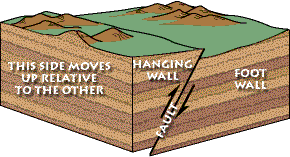Mike dunning dorling kindersle getty images reverse faults form when the hanging wall moves up.
In a reverse fault where does the hanging wall move relative to the footwall.
In a reverse fault the hanging wall moves upward relative to the foot wall.
Alternatively such a fault can be called an extensional fault.
A normal fault is in a zone of tensional faulting rocks in the.
In a reverse fault the hanging wall moves down and the footwall moves up.
In a reverse fault the hanging wall moves upward relative to the foot wall.
A normal fault is in a zone of tensional faulting rocks in the.
In a reverse fault the hanging wall block moves up relative to the footwall block.
True the oldest sedimentary rock strata are exposed along the axial parts of deeply eroded anticlines.
In a reverse fault the hanging wall right slides over the footwall left due to compressional forces.
The hanging wall moves downward relative to the footwall.
A reverse fault is in a zone of compressional faulting rocks in the hanging wall are pushed up relative to rocks in the footwall.
A reverse fault is in a zone of compressional faulting rocks in the hanging wall are pushed up relative to rocks in the footwall.
What types of faults would you.
In a normal fault the hanging wall of the fault moves down relative to the foot wall.










